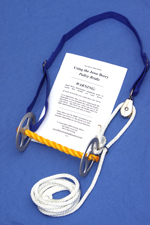1. Would You Want Your Horse To Stop If This Happened?
2. Fixing Pesky Problems BEFORE You Get Hurt
********************************************************
1. Would You Want Your Horse To Stop If This Happened?
Here’s Andy Curry with some good info:
In rodeo competitions, the rider chases a calf.
The horse zooms up next to the calf,
and at the right moment, the cowboy slides off his horse,
onto the calf, and the wrestling match begins.
The horse is trained to do run up to
and along side the calf so the cowboy can do his thing.
But what if you’re not as good at riding a horse as these guys?
What if you have a son or daughter who
you worry about falling off the horse and the horse doesn’t stop?
That would be especially bad if a foot was caught in the stirrup.
Ouch.
Would you rather have a horse taught to stop or
slow down if you’re falling off?
Why would you want that?
Well, if you’re not a rodeo-er or into
Dressage, etc., then chances are you’re more
into trail ridin’ and easy goin’ stuff.
T’ain’t nothin’ wrong with that. In fact, that’s a
very big portion of the horse industry today.
So if you’re not an experienced rider, break easier
‘n you used to, and want your horse to stop if you fall
off or maybe even slow down if he feels you slipping,
that can be done.
Diana Quintana, one of featured trainers,
teaches that very thing to horses.
She’ll take a ‘deflated innertube’
(with the stem removed) and put it on a horse.
She’ll start by having the horse walk around with it on.
Not trot or lope…walk. (I might add the horse may need
to get used to it being on his back first. You can’t always throw it on and go.)
Anyway, once the tube is on, have the horse walk a calm, steady pace.
As he does, watch for the inner tube to come off… because it will.
As it starts to slip, the horse will notice it.
That’s the horse’s cue…when it starts to slip.
That mimics a rider starting to slip off.
Then when the tube hits the ground, stop the horse.
And once it’s on the ground around the horses feet,
you want him to accept it and not freak out about it.
You want him calm and cool about it.
Why?
Because you always want your horse to remain calm and cool
regardless of the situation. That way, you don’t have to fight
a thousand pounds of out-of-control muscle. Instead, it’s taught self control.
When you get him doing this well at the walk then you
can go to the trot – but not until then.
Now there’s a little more to it than what I told you because
words don’t do it justice, some things ought to be seen for clarity.
But you get the gist.
And if you haven’t yet seen Diana’s video, you might take
a look at it. To read about it, click the following:
I almost forgot to tell you.
Whenever you get Diana’s video, you also get a bonus.
It’s Diana’s personal 30-Day Horse Training plan.
If you want to know what to do from day 1 up to 30 days,
this is a very valuable resource.
*************************************
2. Fixing Pesky Problems BEFORE You Get Hurt
I get many, many emails from folks who just don’t know
what to do to fix all kinds of problems they’re having
with their horses.
(By the way – there’s just no physical way I can answer
all of them – so if you didn’t get a response from me, I apologize.
There just isn’t enough time in the day.)
A lotta of the problems relate to not learning the basics
of controlling your horse.
It all starts with understanding how your horse learns, how his
brain works and how you fix good – or bad – habits into his brain.
However, there is good news! I’m bettin’ that ANY problem you
could come up with in ANY horse has already been figured out and
fixed by trainers, even a century or more ago.
After years and years of proven horse training methods and
thousands of horses fixed from every problem you can imagine,
effective solutions exist that any horse owner can take advantage of.
Think your problem is unique? It probably isn’t. The nature of
the horses and their problems hasn’t changed in hundreds, if not
thousands of years.
Read about the Jesse Beery Course in Horse Training. If his course
doesn’t directly address the problems you are having and/or
doesn’t provide effective methods to fix the problems then
send it back.
Jesse Beery Horse Training Course
However, what you’ll learn in the process is life-changing.
You’ll get a better understanding of any horse you handle
or ride and will know how to address almost any issue that
comes up with your horses. From starting a colt to fixing
all kinds of bad habits… YOU will have control.
Click the link below and read about it for yourself:
Jesse Beery Horse Training Course
Ok.. that’s it for today…
work with your horses – but do it safely.
Charlie
++++++++++++++++++++++++++++++++++++++++++++++++++++
Want to buy your first horse and don’t want
to make the wrong choice?
This complete horse-buying manual helps you find,
select and buy the right horse.
You can save thousands of dollars by getting the
right, healthy, horse suited for the style of
riding you want.
But it isn’t always obvious and some folks just
don’t tell the whole truth when showing you their
horses for sale.
If you don’t have the experience then you need
this manual!
Check it out here now:
How To Buy A Horse and Not Get Taken Advantage Of
+++++++++++++++++++++++++++++++++++++++++++++++++++++++++


